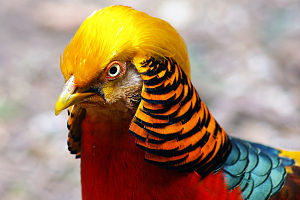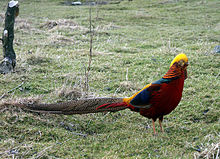Golden pheasant
| Golden pheasant | ||||||||
|---|---|---|---|---|---|---|---|---|

Portrait of a male golden pheasant |
||||||||
| Systematics | ||||||||
|
||||||||
| Scientific name | ||||||||
| Chrysolophus pictus | ||||||||
| ( Linnaeus , 1758) |
The golden pheasant ( Chrysolophus pictus ) is a Hühnervogel art from the family of pheasant-like . The rooster of this species is one of the most colorful pheasants with its golden-yellow hood and the equally colored rump, the intensely red underside and the green and blue shimmering areas on the back and wings. The hen is mostly banded beige-brown and black. The natural distribution area is in central China , where the golden pheasant lives in subtropical mountain jungles up to 2500 m altitude. Naturalized populations exist in the UK .
description
The cock's body length is about 100 cm, of which about 77-79 cm is the tail. The wing length is between 190 and 200 mm, the weight between 700 and 800 g. The hen is about 60 cm long, the tail measures 35-37 cm. The wing length is 165-180 mm, the weight about 700 g.
The head of the rooster is shiny golden yellow and wears a long feather hood that falls down to the neck. In contrast to other pheasants, the featherless area around the eye is yellow-brown and not very extensive. The iris is light yellow, the beak yellowish horn-colored. The rectangular feathers, which are only slightly rounded at the bottom, of the “collar” typical of the genus are orange-yellow with a black hem, a central black band and an orange-brown base. The entire underside is intensely dark red, the chin and throat as well as the middle of the abdomen and the thigh plumage are a bit more brownish. The metallic, dark turquoise-green feathers on the front back are broad, slightly rounded at the end and lined with black. They show a golden sheen towards the end. The rest of the back, rump and tail-coverts are intense yellow, less shiny and a little lighter than the top of the head. The lateral rump feathers are red at the tip, the rear upper tail-coverts up to 25 cm long, lanceolate with a red tip and a basal part that shows the pattern of the two central control feathers . These are roof-shaped in cross-section and have a fine pattern of brown-beige, round spots on a black background. The rest of the tail feathers are brown and with the exception of the single-colored tip, cross-waved black. The black-brown hand wings are rusty yellow, the inner arm wings are lined with red-brown. The inner arm wings and the umbrella springs have a metallic, dark blue shine. The upper wing-coverts are dark red-brown spotty to reason the wing is brownish red. The legs are yellowish horn-colored.
In the hen the featherless eye region is yellow-brown and not very extensive. The iris is brown, the bill yellowish horn-colored with a dark base. The body plumage is mostly banded beige-brown and black. The banding on the top of the head and neck is fine, the base tone is yellowish-brown, the tips are partly blue with a metallic sheen. The chin and throat are unbanded and light. On the front back the banding is broad on a reddish-brown background. The underside is light yellowish beige with wide, black banding on the chest, flanks and under tail-covers, which become finer and taper towards the middle of the abdomen. The lower back, rump and upper tail coverts are finely scribbled patterned on a brown background. The wings are brown with lighter yellowish spots on the outer and lighter reddish brown bands on the inner flag. Towards the arm wings the latter become more yellowish, the shaft areas are reddish and darkly dotted. The control springs are predominantly red-brown with indistinct speckles, the middle control spring pair is banded and scribbled yellowish-brown-black on a brown background. The drawing becomes lighter towards the tips. The feet are yellowish horn-colored.
voice
The rooster’s loud, rough metallic call for territory (audio sample) is compared to the whetting of a scythe. It is presented with one or two syllables at short intervals and carries very far. The excitement call of both sexes (audio sample) is a simple or sequential pwii or pwitt , which can vary in pitch, intensity and hardness depending on the situation. The threatening sound is whimpering high, the cock's call for contact is a soft chuckle reminiscent of the guinea fowl . The hen emits a chuckling tluck tluck in the case of enemies of the ground and a quiet, soft meow in the case of enemies of the air . The fear and alarm call is a shrill iiiihhh . In addition to hissing and squeaking noises that can be heard during courtship, the rooster utters a soft, house-chicken-like oor oor as a lure call during courtship feeding .
Distribution and existence
The monotypic species occurs in central China. The distribution extends there from the southeastern Qinghai and Gansu to the Qin Ling in Shaanxi , southwards over the east of Sichuan , Hubei , Guizhou and Hunan to the northeast of Yunnan and the north of Guanxi . Little is known about the population size, but it is presumably declining due to increasing urban sprawl. However, the IUCN regards the species as not endangered (“ least concern ”) due to its large distribution area and the apparently not too rapid decline . In England, Wales and southern Scotland, the species occurs in the wild in several places.
Way of life
The habitat of this species consists of subtropical jungles on steep mountain slopes at heights of up to 2500 m. It also seeks out tea plantations, field margins and terrace plantations in the outskirts of the cultural landscape, but is never seen in open areas and lives quite secretly in general. For overnight stays, fixed places on branches at a height of 3.5 m are usually sought. In Great Britain the golden pheasant occurs in 10–20 year old coniferous forests of larch or pine, in which suitable thickets alternate with looser tree populations for foraging. There are also occurrences in mixed forests with dense undergrowth of snowberries , boxwood , rhododendrons and sloes .
The golden pheasant lives monogynously during the breeding season and can be found outside the same in pairs or in small groups of up to three birds. While hens become sexually mature in their first year of life, this occurs later in the case of roosters and courtship behavior does not begin until July or August of the second year. Young roosters like to socialize with older roosters in the winter half-year.
During the breeding season, the roosters' calls to territory can be heard at short intervals. In the case of territorial disputes, sometimes violent fights are fought. The courtship begins with the first good weather and begins with the rooster circling the hen at a fast pace with abrupt changes of direction. Just as abruptly he adopts the courtship posture, in which he stands on his legs up to the side of the female and presents himself to the female with the wing slightly lowered. The head is lowered with the collar spread apart and the colored areas of the back and the fanned tail are conspicuously displayed. To do this, the rooster makes hissing sounds. In the early days of the courtship, the hen usually shows little interest, turns away and is pursued again by the rooster, who in turn tries to adopt the courtship position. Later, the hen asks the rooster to mate with crouched posture and drooping wings, during which the rooster often wildly pecks at the hen's crown and tears out feathers. After copulation, the hen usually flees to a tree.
The hen separates itself from the rooster to lay eggs and incubate. The clutch consists of 5–12 shiny creamy white eggs of about 45 × 33 mm in size. The incubation period is 22–23 days. The chicks are 1-2 days brooded and then out with the chicken feed again or hinlockt the chicks to food items. After 12-14 days, the young birds spend the night together with the hen in trees.
Figurative meanings
In ancient China, the golden pheasant marked an empress as an insignia and, among civil servants, used a badge to denote a certain rank. In general, the pheasant was considered a symbol of prosperity, luck and beauty.
In the time of National Socialism , "gold pheasant" was a popular term for high party functionaries of the NSDAP and the military with regard to their pomp with uniforms and medals , above all Hermann Göring , who was also called "Lametta-Heini" in the same sense of the word.
The terms “golden pheasant” and “high animals” are linked by a rhetorical analogy (both terms from the animal kingdom). The novel entitled Goldfasan ( Jan Zweyer , published 2009) deals with this topic in a broader sense.
literature
- Heinz-Sigurd Raethel : Chicken birds of the world. Verlag J. Neumann-Neudamm GmbH & Co. KG, Melsungen 1988, ISBN 3-7888-0440-8 .
- Deer pith: Chrysolophus pictus. In: WJM Hagemeijer, MJ Blair: The EBCC Atlas of European Breeding Birds. Their distribution and abundance. T & AD Poyser, London 1997, ISBN 0-85661-091-7 , p. 220.
Web links
- Chrysolophus pictus in the endangered Red List species the IUCN 2008. Posted by: BirdLife International, 2009. Retrieved on October 16 of 2010.
- BirdLife species factsheet , accessed October 16, 2010
- Videos, photos and sound recordings for Chrysolophus pictus in the Internet Bird Collection
- Photos of Chrysolophus pictus in the Oriental Bird Club image database , accessed October 16, 2010
- xeno-canto: Sound recordings - Golden Pheasant ( Chrysolophus pictus )
- Feathers of the golden pheasant
Individual evidence
- ↑ The rooster call for the area: Golden Pheasant Chrysolophus pictus. In: xeno-canto . Accessed January 2, 2019 .
- ↑ Excitement call of both sexes: Golden Pheasant Chrysolophus pictus. In: xeno-canto . Accessed January 2, 2019 .
- ↑ a b EBCC Atlas, p. 220, s. literature
- ^ Clemens Zerling: Lexicon of animal symbolism. Mythology - religion - psychology . Kösel, Munich 2003, ISBN 3-466-36639-9 .
- ↑ Here come the admirals . In: Frankfurter Allgemeine Zeitung . March 14, 2009, p. 38 .


